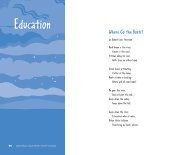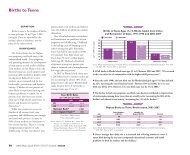2010 Rhode Island Kids Count Factbook
2010 Rhode Island Kids Count Factbook
2010 Rhode Island Kids Count Factbook
You also want an ePaper? Increase the reach of your titles
YUMPU automatically turns print PDFs into web optimized ePapers that Google loves.
Children in Poverty<br />
Financial Asset Building<br />
◆ For working poor families, having assets such as checking and savings accounts<br />
provides families the ability to conduct basic financial transactions, manage financial<br />
emergencies related to unemployment and illness, and invest in education and<br />
training. 28,29<br />
◆ Many low-income families lack knowledge about or access to traditional banks and<br />
instead rely on cash transactions or alternative financial services, such as check-cashing<br />
stores, payday lenders, rent-to-own stores and refund anticipation loans. These families<br />
pay high fees for financial transactions and high interest rates on loans, are more<br />
vulnerable to loss or theft, and often struggle to build credit histories and achieve<br />
economic security. 30,31<br />
◆ In <strong>Rhode</strong> <strong>Island</strong>, 6% of households do not have a checking or savings account. Among<br />
the poorest households, those with incomes less than $15,000, almost one in three<br />
households (31%) have no bank account, a rate that is higher than the U.S. as a whole<br />
(27%) and higher than any other state in New England. 32<br />
◆ Improving financial literacy (i.e., the understanding of money, banking, credit and<br />
how best to build assets) and encouraging banks to provide affordable services can<br />
support low-income families in using traditional banking institutions and increase their<br />
savings. 33<br />
◆ State and federal policies that protect families from predatory mortgage lending and<br />
payday lending and expand cost-effective and safe financial services would allow families<br />
to keep more of their earnings, save and invest more and could ultimately promote a<br />
more stable workforce and stronger communities. 34,35,36<br />
◆ Many public assistance programs have eligibility provisions that limit the amount of<br />
assets and/or the value of vehicles a family can own. Such policies discourage families<br />
from accumulating the assets they need to improve their economic security. <strong>Rhode</strong> <strong>Island</strong><br />
currently has a $1,000 asset limit to qualify for RI Works and is one of only eight states<br />
with such a restrictive asset limit. 37<br />
38 <strong>2010</strong> <strong>Rhode</strong> <strong>Island</strong> KIDS COUNT <strong>Factbook</strong> / Economic Well-Being<br />
Building Blocks of Economic Security<br />
Income Supports<br />
◆ Nationally, income supports lifted 31 million Americans above the poverty line in<br />
2005, cutting poverty nearly in half and helping low-income working families meet their<br />
basic needs. Income supports can be cash payments, such as the <strong>Rhode</strong> <strong>Island</strong> Works<br />
Program; tax credits including the Earned Income Tax Credit and the Child Tax Credit;<br />
and “near-cash” benefits, such as SNAP (food stamps), child care and housing assistance<br />
that are not provided in cash but which are used to pay regular monthly bills. 38<br />
Access to Health Care<br />
◆ Families with incomes below the poverty level are much less likely to receive health<br />
insurance through an employer than their higher-income counterparts. Some low-income<br />
workers are ineligible because they work part-time or are recent hires, while others<br />
cannot afford to pay the employee share of the insurance premium. 39 Children with<br />
health insurance (public or private) are more likely than children without insurance to<br />
have a regular and accessible source of health care. 40<br />
Affordable Quality Child Care<br />
◆ High-quality, affordable child care helps parents maintain employment and supports<br />
children’s development. 41 Child care costs represent a significant portion of low-income<br />
families’ budgets. On average, families living below the poverty threshold spent 25% of<br />
their income on child care, compared to 7% for families above the threshold. 42<br />
Educational Attainment<br />
◆ Eighty-three percent of children whose parents lack a high school diploma and over half<br />
of children whose parents have only a high school diploma live in low-income families. 43<br />
Greater access to adult basic education and English as a second language courses is<br />
necessary to ensure that all parents have the skills necessary to participate in the workforce.<br />
Higher education is one of the most effective ways that parents can raise their families’<br />
incomes. Increasing access to financial aid and child care subsidies for parents pursuing<br />
higher education can make higher education more accessible to low-income parents. 44<br />
Affordable Housing<br />
◆ Having stable housing is critical for getting and keeping a job. 45 In 2009, the average<br />
rent for a two-bedroom apartment in <strong>Rhode</strong> <strong>Island</strong> was $1,170. 46 In <strong>Rhode</strong> <strong>Island</strong>, a<br />
family of three with an income at the federal poverty level would need to spend 77% of<br />
its income on rent to pay this amount, well above the recommended percentage of 30%. 47






